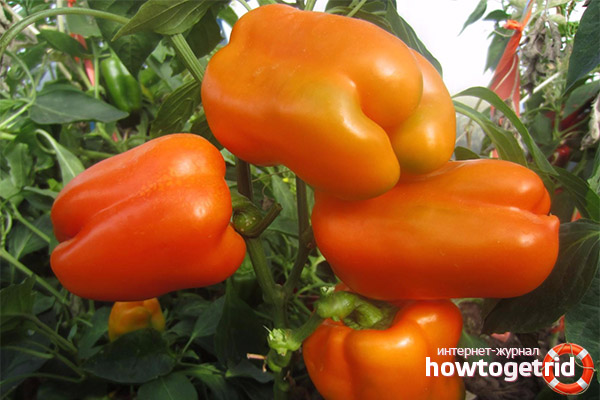The content of the article
The plant reaches a height of no more than 95 cm. The ripe fruit has a bright orange hue and cone shape. With proper care and favorable climatic conditions, up to three kilograms of product can be collected from one bush. The average fruit weight is 150 g.
Cultivation and care
The culture is mainly grown by seedlings. If you do not want to spend money on seedlings, then you can grow it yourself.
- The first thing to do is to make a selection of seeds, they should be poured with a glass of water, those that come up are considered marriage. After this, carry out the hardening procedure. Seeds are briefly placed in a non-concentrated solution of potassium permanganate. This procedure will help to avoid the emergence of further fungal diseases.
- Do not deepen the seeds when planting in the soil, as this can slow down the development of pepper. For seedlings, it is advisable to use small peat pots. Approximately two weeks before planting in open ground, take seedlings out onto the street.
- When planting in open ground, consider the fact that pepper prefers loamy, not dense soil. In the same case, if the plant is to be grown on poor soils, it will often have to be fed with various complex fertilizers.
- Ideal precursors for this culture are cucumber, cabbage, onions, beans, peas. Seedlings are grown 65 days before the expected moment of planting in open ground.
Peppers should not be placed too close to each other. One square meter should not have more than three plants. It is advisable to fertilize before flowering.
Watering
The main thing is to ensure that the soil near the bushes does not dry out. Watering itself should be done directly under the root, otherwise there is a risk of sunburn. For irrigation it is necessary to use warm, settled water, into which, if desired, you can add a little wood ash.
Do not neglect mulching. Use mowed grass, straw or sawdust for mulch. Under the mulch layer, the soil remains moist longer.
Stepson
Do not neglect this procedure, it will help direct all the energy of the plant to the development of the fruit, not the bush. But for all its merits, it is worth remembering that it can not be produced too often, since it can harm the plant. Ideally, it is better to carry out on more than once every two weeks, and at a time to remove no more than three processes.
When growing pepper in a garden plot, keep in mind that the plant is very poor in wind. Therefore, landing sites need to choose the most protected from it. Garden plots are usually open to the wind, for this reason it is better to cultivate the Red Tail variety in greenhouse conditions.
Advantages and disadvantages
The advantages of this variety include resistance to most diseases and pests, increased transportability, which makes it possible to grow pepper for commercial purposes.
This culture also has impressive shelf life. It can be consumed both fresh and canned. Suitable for stuffing, has high taste.
Video: F1 Red Tail Pepper










Submit